My first memory of tasting that mysterious surprise found at the center of these bones was with my parents. We were eating osso buco at a dinner party or something like that, and my mom had a small spoon stuck right into a center of the shank's bone. I found it peculiar that my parents would do that -- I didn't think bones were for eating. I gave my mom a puzzled, doubtful look, and she knew exactly what I was thinking. Explaining to me that it was bone marrow (the best part of osso buco, she emphasized), I was highly skeptical about whether or not I would find it appetizing. Boy, did that first taste change my perspective on trying new things, not only for bone marrow but venturing into the mysterious realm of offal and the rich (yet guilt-inducing) things it has to offer.
So after some foraging through the interwebs for recipes, I found two that was fitting for our scrupulous "study" of bone marrow. The first is a starter course (i.e., roasted bone marrows with parsley salad) that I found via The New York Times recipe archive -- adapted from London chef, Fergus Henderson, and his original recipe. This very recipe was also one that was a recurring find in my recipe search, proving it is a very "classic" and timeless way to prepare and serve marrow bones.
I was hoping that the meat department would be able to cut the bones for me in a specific manner. It is recommended for roasted bone marrow that you request for a femur bone to be sliced into pieces -- either horizontally (one long bone sliced in half) or diagonally (in three-inch cylindrical pieces).
{1} I didn't strike gold, but I did find frozen marrow bones at Whole Foods Market in Tribeca, packaged away at the bottom of the self-serving freezers by the meat department. It was almost as if they were sent into a shaming exile, almost nowhere to be found, until I had asked one of the butchers about whether or not Whole Foods had any that day. When I asked, it almost felt like I was shopping for unmentionables in a you-know-what shop. When the butcher asked me how much I needed, I recited both recipes -- the first needing 3-4 pounds and the other needing 6 whole bones (I wasn't even sure what that meant -- so vague!). Wide-eyed, the butcher simply said, "Whoaaa that's A LOT of bone marrow! Not sure if you need that much -- each package here is about one whole bone or so. I figure you'll probably only need a few or so packages." Mostly embarrassed and feeling awkward, I quickly got myself six packages (averaging 1.5 to 1.75 pounds each) at a surprising $3.99 per pound -- hoping it would be enough for our first course of roasted bone marrow and our main course (more details on this shortly). {2} I unpacked the bloody, frozen blocks from their packages a little over 24 hours before our dinner into large bowls (I could fit them into three) -- this is part of the preparation process as well as ensuring that the bones have sufficient time to defrost.
{3} Aussie expert Jennifer McLagan urges that marrow bones must be soaked in ice water for 12-24 hours beforehand in order to extract any blood from the bones. I did this by placing the bones in large bowls and filling the bowls to cover with ice water, followed by 2 tablespoons of coarse sea salt. I then refrigerated the bowls, changing the water 4-6 times, adding 2 tablespoons of salt after each change. {4} Twenty-four hours later, I drained one bowl's worth of bones from the water one last time, patting them dry with paper towels and placing them on a foiled baking sheet. Lisa and I then generously salted the marrow bones on the sheet, at the same time preheating the oven to 450 degrees Fahrenheit before placing the sheet in the oven. Once the oven is ready, you can place the marrow bones in the oven, cooking for approximately 15 minutes for bones that are three inches thick (you can calibrate the cooking time, depending on the thickness of the bones).
We also threw in 2 loaves of bread, horizontally sliced, in the oven to cook for a minute or so to thaw and toast (they had originally been frozen) for serving.
{1} While the oven was cooking, Lisa and I put together the parsley salad using 2 shallots, 2 teaspoons of lemon juice, two teaspoons of capers, and two cups of loosely chopped Italian parsley. {2} In a small bowl, we combined the parsley, shallots (thinly sliced), and capers. Whisking together 1.5 tablespoons of olive oil and lemon juice in a separate bowl, we drizzled the resulting dressing over the parsley mixture until the leaves are just coated.
After the initial 15 minutes in the oven, the marrow in the bones were not quite bubbling at the top, so Lisa and I decided to leave them in for another 5 minutes. This lead to another 5 minutes, when the bone marrow seemed to finally be ready to serve. Be sure to have a well-ventilated kitchen when you're roasting the bone marrow in the oven. The apartment's alarm went off a couple times because I failed to open a window for the smoke and warm air to waft out of the kitchen to avoid setting off the smoke detector.
Look at those gorgeous bones filled with hot and creamy marrow! The slightly scorched tops give them some more flavor.
With the bone marrow ready to be scooped out, the parsley salad all dressed, and the loaves of bread all toasted, we had our first taste of the roasted bone marrow spread topped with parsley salad over toasted baguette.
Lisa brought over a lovely 2007 Bordeaux La Réserve produced by Château Haut-Brisson in Libournais, France -- a blend of merlot, cabernet sauvignon, and cabernet franc. She found this wine at the famous Wine Library in North Jersey. A solid choice for bordeaux, as it especially makes for a nice pairing with steak and marrow! We decanted it for a little so the one could breathe and release its intense flavors.
After finishing up the roasted bone marrows, Lisa and I continued on with our second (and last) course for the night. It was a recipe for grilled steak with red wine sauce and bone marrow that I found via Serious Eats from its Cook the Book section. The recipe is actually an excerpt from Jennifer McLagan's cookbook, Fat: An Appreciation of a Misunderstood Ingredient, with Recipes. Before we started, we preheated the over broiler on high.
The recipe called for {1} dry red wine (we had a Merlot from Long Island on hand), concentrated veal stock (we used a beef/veal demi-glace), {2} four chopped shallots, one carrot thinly sliced, 3 sprigs of thyme, 1 fresh bay leaf, and 1.2 teaspoon crushed peppercorns. {3} We first diluted the demi-glace into a cup or so of veal stock -- the recipe calls for two concentrated, but since I only had demi-glace only enough for 1 cup of veal stock, we had to make do. {4} While we kept the diluted veal stock warm over heat, Lisa and I combined the vegetables, herbs, and wine in a Dutch oven, bringing it to a boil. Once it started boiling, we reduced the heat, boiling gently until liquid reduced to 2/3, which took about 15-20 minutes.
{1} After the wine-vegetable-herb mixture finally reduced, we added in the veal stock, continuing to boil until it was reduced by half. The recipe calls for "poaching" the bone marrow in half-inch slices. This was a problem for us, however, mainly because the marrow bones I had bought had been previously frozen and had not thawed complete enough for us to push out the marrow from the bones. To compensate for this, {2} Lisa and I decided to throw in the marrow bones right into the sauce so that the marrow can loosen up from the heat and cook at the same time. Plus, the sauce will be even tastier from all of the flavorful juices from the bone marrow! We let this boil on medium heat for about 20 minutes, {3} until the sauce reduced and the marrow was loose and thoroughly cooked. {4} We emptied out the marrow bones (while the steak was resting -- see below), one by one, with the back end of a spoon, {5} amalgamating to a stockpile of marrow ready to dress the seared rib steak!
We had two bone-in rib steaks sitting out an hour before we started cooking. One thing to note is that we deviated a bit from the recipe, by using 2-inch steaks instead of 3-inch (it was all FreshDirect had available at the time). {1} With the sauce mixture reducing on the stove, we seasoned the steaks generously with Kosher salt and freshly ground pepper and placed them on a foiled and lightly oiled baking sheet {2} At that point, the broiler was ready for us to sear the steaks with an oven rack placed as close to the top of the stove as possible, {3} 1 minute per side. Once the steaks were seared, we moved the rack farther away from the heat (to the lowest notch in the oven), continuing to cook the steaks, turning once, about 10-14 minutes. Since we had an inch less than what the recipe called for, we cooked on the lower end of the timing spectrum, about 8-10 minutes. {4} After 10 minutes, we took the steaks out of the oven, cutting them open to see if they had been cooked all the way through. Looked like they were on the slightly overcooked side (Lisa and I like our steaks medium rare), but it looked like a pretty pink medium. We let the steaks sit for another 5 minutes before plating and dressing them. Noted for next time: always better to underestimate the time -- that way you can gauge how much longer to leave it back in the oven.
{1} The remaining sauce in which the bone marrow was cooking in was kind of oily -- a tiny drawback from our alternative approach to poaching the marrow. So what to do in response to our original improvisation of "making do"? Improvise some more! Lisa came up with the brilliant idea to pour the sauce into a food processor so that it could be a more cohesive sauce -- both in texture and consistency. A few seconds in the food processor, and we had our red wine sauce thick and bursting with warm flavor. {2,3} With Lisa topping the sliced bone-in rib steaks with some chunks of bone marrow, I drizzled and dressed it up with the puréed red wine sauce for a hearty presentation!
Findings: And just like the sensation I had upon my initials bites of our featured courses during our last Table Conviviale dinner featuring foie gras -- the rich and the buttery accompanied by the tender and the hearty. It was certainly one of the densely luscious meals I've had in a while, rivaling the aforementioned foie gras dinner.
The marrow from the roasted femur bones was creamy with a subtle nuttiness that you don't experience in many foods -- the rich, buttery texture makes it ideal for spreading over bread. The parsley salad is well-balanced as the acidity from the lemon juice and the leafy greens counters and cuts through the fattiness of the marrow. The baguette was a good neutralizer, too, keeping the richness of the spread and salad out by intake. I also found that the bigger bones don't necessarily have the highest marrow content -- the medium-sized and smaller ones tend to be the keepers of the savory treasure. With that being said, Lisa had better luck picking the bones that had the most marrow than I did. Now I know better for next time! Additionally, prior to this, Lisa had never had marrow straight from the bone like this. I can safely and happily say that she is now a bone marrow enthusiast! All in all, much success here!
As for the seared steak with red wine sauce and bone marrow, we once again surprised my expectations by executing an incredible main course, especially one with a pretty vague recipe (e.g., unclear cooking times, lacking in directions as to how to remove marrow from bones prior to poaching, etc.). Saved by our clever wit (or I'd like to think so, haha) and my beloved food processor, the red wine sauce and bone marrow complemented the succulently tender ribs of steak. The intense flavors from the braised marrow in the sauce, as well as the other ingredients, blended well to dress the lone beef meat. The marrow itself was heavenly -- melting in your mouth as you slipped each morsel for each bite. Buttery, pleasantly oozing, creamy, and a tinge bit nutty, it was everything I had hoped for and more. Lisa and Marcus were happily content with the results, too.
Now, I have some reflections on the recipes. We lowballed the amount of bones needed for the recipe. We thought the two of us only needed two pounds of marrow (a package and a half), but the larger sized bones yielded less than we had anticipated. As it turns out, it's the smaller bones that carry more chunks (and they're larger in size!) at its center -- noted for the next time I'm cooking with bone marrow! As for the Serious Eats recipe, the portions resulting from two 2-inch bone-in rib steaks was more than enough for Lisa, Marcus, and me -- with half a steak leftover for the next day. So I recommend following the recipe's portions of 3-inch steaks if you have more than 4 people. If not, 2-inch cuts are plenty! Also, I would love to properly poach the bone marrow for my next attempt at this dish, which would mean to buy the bone marrow at least 36 hours in advance so there is enough time elapsed to thoroughly defrost the frozen bones.
Overall, Lisa and I proved to be a great team in the kitchen once again, where I feel confident enough to say that there shouldn't be anything we can't attempt to tackle recipe-wise now! We're going to step it up for our next Table Conviviale dinner. We are in talks about cooking with fresh sea urchin -- details to come!
Price point: 6 packages of bone marrow (approximately 1.5-1.75 pounds each) at $3.99 per pound from Whole Foods Market, two 2-inch bone-in rib steaks (approximately 3.75 pounds total) at $12.99 per pound via FreshDirect, $29.99 for a bottle of Château Haut-Brisson 2007 Bordeaux from Wine Library.
--January 20, 2012
The New York Times
"Roasted Bone Marrows" recipe from The New York Times: October 31, 2007
adapted from Chef Fergus Henderson
Serious Eats
"Grilled Steak with Red Wine Sauce and Bone Marrow" recipe from Cook the Book section
adapted from Jennifer McLagan's cookbook, Fat: An Appreciation of a Misunderstood Ingredient, with Recipes (found here on Amazon)
FreshDirect
Wine Library
586 Morris Avenue
Springfield, New Jersey 07081

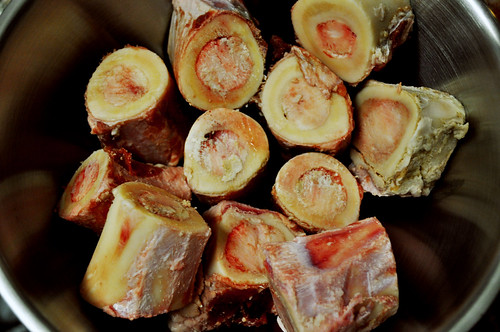


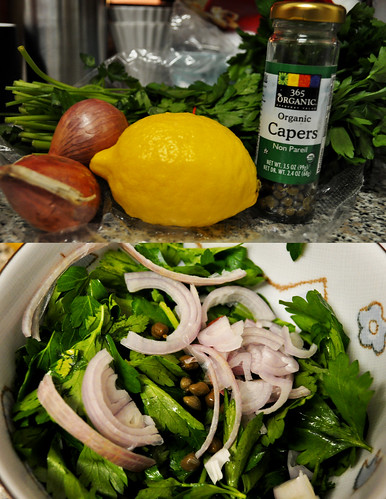



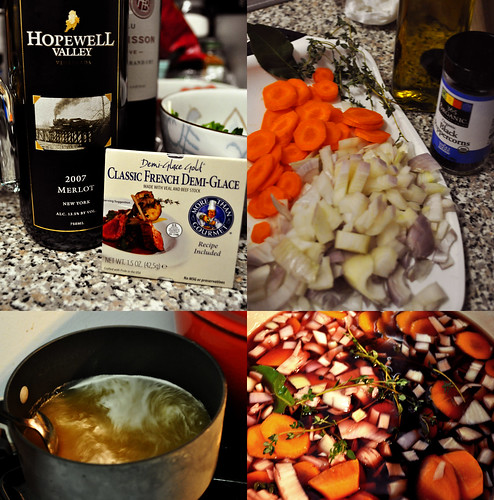
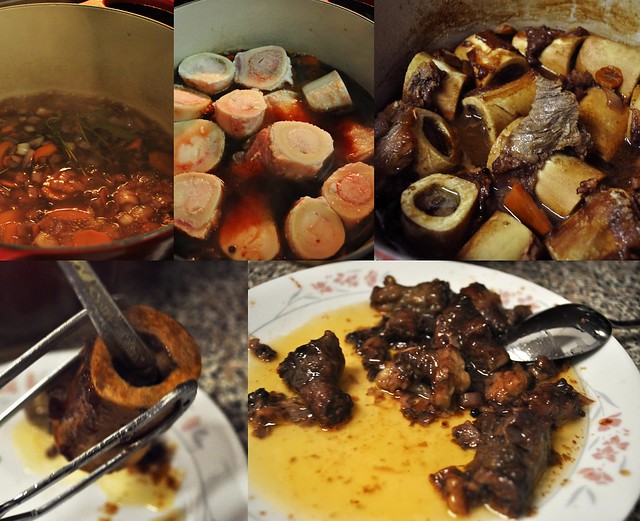

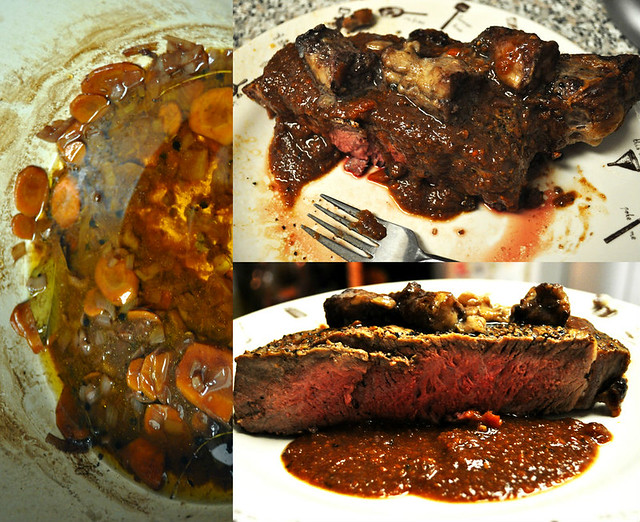
Hello! I enjoyed reading your post. I love it when people improvise, that is how you should approach most recipes. Perhaps you should invest in an instant read thermometer to help with cooking your steak. I am sorry you used the version of the recipe from Serious Eats and not directly from the book, where there it is carefully explained how to extract the marrow from the bone.
ReplyDeleteI have an even simpler way to extract the marrow in Odd Bits - leave the bones (the marrow must be accessible at both ends of the bone) at room temperature for about 15 minutes, run a small knife between the bone and the marrow and then push the marrow out of the bone with your thumb, starting at the narrow end.
Thanks for the kind words, Jennifer! It was such a pleasure working with your recipe -- however abbreviated it was! I'll be sure to use your tips the next time I use bone marrow :) I've also taken the liberty of ordering Bones, Fat, and Odd Bits to add to my ever-growing collection of cookbooks! Thanks again :)
ReplyDeleteGlad you liked Haut-Brisson La Reserve 2007! Your meal looked absolutely fabulous - I've shared it on our facebook
ReplyDeletehttps://www.facebook.com/pages/Chateau-Haut-Brisson-Saint-Emilion-Grand-Cru/
You should try the 2009 too! it's a great wine (though the 2007 is currently my favourite)